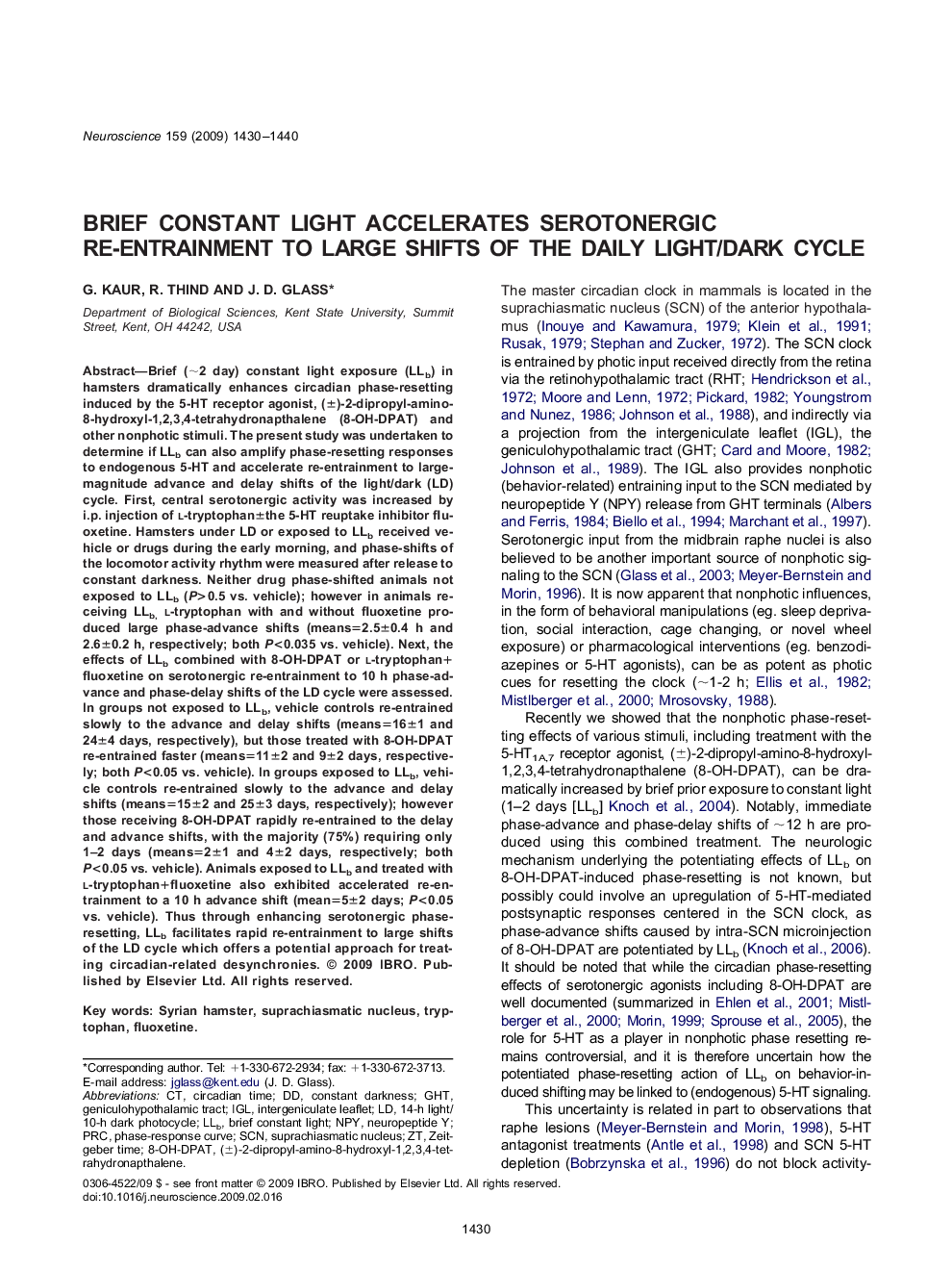| کد مقاله | کد نشریه | سال انتشار | مقاله انگلیسی | نسخه تمام متن |
|---|---|---|---|---|
| 4339890 | 1295772 | 2009 | 11 صفحه PDF | دانلود رایگان |
عنوان انگلیسی مقاله ISI
Brief constant light accelerates serotonergic re-entrainment to large shifts of the daily light/dark cycle
دانلود مقاله + سفارش ترجمه
دانلود مقاله ISI انگلیسی
رایگان برای ایرانیان
کلمات کلیدی
LLBPRCNPYSCN8-OH-DPATIGL - ایگلconstant darkness - تاریکی دائمیTryptophan - تریپتوفانintergeniculate leaflet - جزوه بین المللیGeniculohypothalamic tract - دستگاه GeniculohypothalamicCircadian Time - دوران جوانیZeitgeber time - زمان تایمرGhT - غایتFluoxetine - فلوکستینPhase-response curve - منحنی فاز پاسخSuprachiasmatic nucleus - هستههای سوپراکیاسماتیکSyrian hamster - همستر سوریهNeuropeptide Y - یوروپروتئین Y
موضوعات مرتبط
علوم زیستی و بیوفناوری
علم عصب شناسی
علوم اعصاب (عمومی)
پیش نمایش صفحه اول مقاله

چکیده انگلیسی
Brief (â¼2 day) constant light exposure (LLb) in hamsters dramatically enhances circadian phase-resetting induced by the 5-HT receptor agonist, (±)-2-dipropyl-amino-8-hydroxyl-1,2,3,4-tetrahydronapthalene (8-OH-DPAT) and other nonphotic stimuli. The present study was undertaken to determine if LLb can also amplify phase-resetting responses to endogenous 5-HT and accelerate re-entrainment to large-magnitude advance and delay shifts of the light/dark (LD) cycle. First, central serotonergic activity was increased by i.p. injection of l-tryptophan±the 5-HT reuptake inhibitor fluoxetine. Hamsters under LD or exposed to LLb received vehicle or drugs during the early morning, and phase-shifts of the locomotor activity rhythm were measured after release to constant darkness. Neither drug phase-shifted animals not exposed to LLb (P>0.5 vs. vehicle); however in animals receiving LLb,l-tryptophan with and without fluoxetine produced large phase-advance shifts (means=2.5±0.4 h and 2.6±0.2 h, respectively; both P<0.035 vs. vehicle). Next, the effects of LLb combined with 8-OH-DPAT or l-tryptophan+fluoxetine on serotonergic re-entrainment to 10 h phase-advance and phase-delay shifts of the LD cycle were assessed. In groups not exposed to LLb, vehicle controls re-entrained slowly to the advance and delay shifts (means=16±1 and 24±4 days, respectively), but those treated with 8-OH-DPAT re-entrained faster (means=11±2 and 9±2 days, respectively; both P<0.05 vs. vehicle). In groups exposed to LLb, vehicle controls re-entrained slowly to the advance and delay shifts (means=15±2 and 25±3 days, respectively); however those receiving 8-OH-DPAT rapidly re-entrained to the delay and advance shifts, with the majority (75%) requiring only 1-2 days (means=2±1 and 4±2 days, respectively; both P<0.05 vs. vehicle). Animals exposed to LLb and treated with l-tryptophan+fluoxetine also exhibited accelerated re-entrainment to a 10 h advance shift (mean=5±2 days; P<0.05 vs. vehicle). Thus through enhancing serotonergic phase-resetting, LLb facilitates rapid re-entrainment to large shifts of the LD cycle which offers a potential approach for treating circadian-related desynchronies.
ناشر
Database: Elsevier - ScienceDirect (ساینس دایرکت)
Journal: Neuroscience - Volume 159, Issue 4, 10 April 2009, Pages 1430-1440
Journal: Neuroscience - Volume 159, Issue 4, 10 April 2009, Pages 1430-1440
نویسندگان
G. Kaur, R. Thind, J.D. Glass,